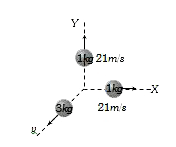A body of mass 5 kg explodes at rest into three fragments with masses in the ratio 1 : 1 : 3. The fragments with equal masses fly in mutually perpendicular directions with speeds of 21 m/s. The velocity of the heaviest fragment will be -
11.5m/s
14.0m/s
7.0m/s
9.89m/s
The correct Answer is:D

Px=m×vx=1×21=21kgm/s
Py=m×vy=1×21=21kgm/s
∴ Resultant =√P2x+P2y=21√2kgm/s
The momentum of heavier fragment should be numerically equal to resultant of →Pxand→Py.
3×v=√P2x+P2y=21√2∴v=7√2=9.89m/s
Topper's Solved these Questions
- WORK , ENERGY , POWER AND COLLISIONBOOK - ERRORLESS CHAPTER - WORK , ENERGY , POWER AND COLLISIONEXERCISE - Ordinary Thinking (Objective Questions) (Perfectly Inelastic Collision)
30 Videos
- WORK , ENERGY , POWER AND COLLISIONBOOK - ERRORLESS CHAPTER - WORK , ENERGY , POWER AND COLLISIONEXERCISE - Critical Thinking (Objective Questions)
20 Videos
- WORK , ENERGY , POWER AND COLLISIONBOOK - ERRORLESS CHAPTER - WORK , ENERGY , POWER AND COLLISIONEXERCISE - Ordinary Thinking (Objective Questions) (Power)
31 Videos
- WAVES AND SOUNDBOOK - ERRORLESS CHAPTER - WAVES AND SOUNDEXERCISE - SET
25 Videos
- WORK, ENERGY, POWER & COLLISIONBOOK - ERRORLESS CHAPTER - WORK, ENERGY, POWER & COLLISIONEXERCISE - Assertion
30 Videos
Similar Questions
A body of mass 1 kg at rest explodes into three fragments of masses in the ratio 1 : 1 : 3 . The two pieces of equal mass fly in mutually perpendicular directions with a speed of 30m/s each . What is the velocity of the heavier fragment ?
View SolutionA body of mass 1kg initially at rest explodes and breaks into threee fragments of masses in the ration breaks into three fragments of masses in the ration 1:1:3. The two pieces of equal masses fly off perpendicular to each other with a speed of 30m/s each What is the velocity of heavier fragments ? .
View Solution
Knowledge Check
A body of mass 1kg initially at rest, explodes and breaks into three fragments of masses in the ratio 1:1:3. The two pieces of equal mass fly off perpendicular to each other with a speed of 15ms−1 each. What is the velocity of the heavier fragment?
A10√ms−1B5√3ms−1C10√3ms−1D5√2ms−1A shell of mass m is at rest initially. It explodes into three fragments having masses in the ratio 2:2:1. The fragments having equal masses fly off along mutually perpendicular directions with speed v. What will be the speed of the third (lighter) fragment ?
AvB√2vC2√2vD3√2vA body of mass 1kg initially at rest explodes and breaks into three parts of masses in the ration 1:2:3. If the two pieces of equal masses fly off perpendicular to each other with a speed of 30m/s The speed of third piece will be .
A10√2m/sB20√2m/sC5√2m/sD40√2m/s
A body of mass 1 kg initially at rest explodes and breaks into three fragments of masses in the ratio 1: 1: 3. The two pieces of equal mass fly off perpendicular to each other with a speed of 30ms−1 each. What is velocity of the heavier fragment?
View SolutionA bomb of mass 5m initially at rest explodes and breaks into three pieces of masses in the ratio 1:1:3. The two pieces of equal mass fly off perpendicular to each other with a speed of v0. What is the velocity of the heavier piece? Also , calculate the energy released in explosion.
View SolutionA shell is fired from a cannon with a speed of 100m/s at an angle 30∘with the vertical (y-direction). At the highest point of its trajectory, the shell explodes into two fragments of masses in the ratio 1:2. The lighter fragment moves vertically upwards with an initial speed of 200m/s. What is the speed of the heavier fragment at the time of explosion?
View SolutionA body of mass 5m initially at rest explodes into 3 fragments with mass ratio 3:1:1. Two of fragments each of mass 'm' are found to move with a speed 60m/s in mutually perpendicular direction. The velocity of third fragment is
View SolutionA body of mass 4m at rest explodes into three fragments. Two of the fragments each of mass m move with speed v in mutually perpendicular directions. Total energy released in the process is
View Solution
